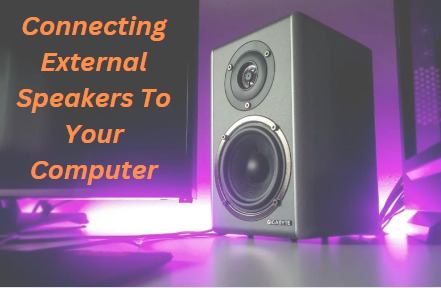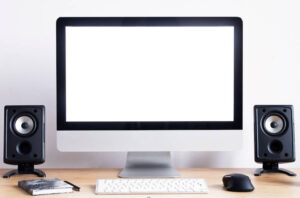
Connecting external speakers to your computer can greatly enhance your audio experience, whether you’re watching movies, listening to music, or playing games. Built-in computer speakers often lack the power and clarity needed for high-quality sound, leaving you with a flat and unsatisfying audio experience. By adding external speakers, you can enjoy richer bass, clearer vocals, and an overall more immersive sound.
Not only do external speakers improve sound quality, but they also offer more flexibility in terms of volume and placement. You can position your speakers for the best possible sound, creating an optimal listening environment tailored to your preferences. This setup is especially important for tasks that require precise audio, such as editing videos, mixing music, or enjoying high-definition entertainment.
One of the most important aspects of a computer’s functionality is the ability to play audio, and connecting external speakers to your computer can drastically improve the quality of sound. In this article, we will explain the importance of connecting external speakers to your computer, and how to do it properly. You will also explore different methods, and step-by-step instructions, and answer common questions to help you Connect Speakers to a PC Without an Amplifier.
Why External Speakers Are Better Than Built-In Ones?
While most computers come with built-in speakers, they are often not powerful enough to provide high-quality audio, especially when it comes to bass and treble. In addition, built-in speakers are typically located in a place that does not allow for optimal sound projection, resulting in audio that is often muffled and lacks depth.
External speakers, on the other hand, are specifically designed to produce better sound quality and can be placed in a location that allows for optimal sound projection. They come in a variety of shapes, sizes, and price ranges, making it easy to find the perfect fit for your needs.
Steps On How To Connect External Speakers To Your Computer:
1. Locate The Audio Output Ports On Your Computer:
These are usually located on the back of the computer, but they may also be located on the front or sides. The audio output ports are typically labeled as “Line Out,” “Speaker Out,” or “Headphone Out.”
2. Find The Audio Input Ports On Your Speakers:
These are usually located on the back of the speakers, but they may also be located on the sides. The audio input ports are typically labeled as “Input,” “Audio In,” or “Line In.”
3. Connect The Speakers To The Computer Using An Audio Cable:
The audio cable will have a 3.5mm plug on one end and two RCA plugs on the other end. If your computer has a 3.5mm audio output port, you will need to use a 3.5mm RCA adapter.
4. Plug The Speakers Into A Power Outlet:
If your speakers require external power, you will need to plug them into a power outlet.
5. Check The Volume Settings On Your Computer And Speakers:
Make sure that the volume is turned up on both your computer and speakers.
Note1 :- If you have followed these steps and your speakers are still not working, there are a few other things you can check:
- Make sure that the audio cable is properly connected to both the computer and the speakers.
- Try using a different audio cable.
- Restart your computer.
- Update your computer’s sound drivers.
Note2 :- If you are still having trouble, you can consult the user manual for your speakers or computer for more troubleshooting help.
Here are some additional tips for connecting external speakers to your computer:
- If your computer has a USB port, you can use a set of USB speakers. These speakers will plug directly into the USB port and do not require an audio cable.
- If you have a 5.1 or 7.1 surround sound system, you will need to use a different type of audio cable. These systems use multiple speakers and require a special audio cable to connect them to your computer.
- If you are having trouble getting the sound to come out of both speakers, check the speaker balance settings on your computer.

Some More Steps To Connecting External Speakers To Your Computer
Now that we have established why external speakers are important, let’s dive into how to connect them to your computer. The process is relatively simple and can be done in a few easy steps.
Step 1: Check The Audio Jacks On Your Computer
The first step is to check the audio jacks on your computer to determine what type of cable you will need to connect your speakers. Most computers come with a standard 3.5mm audio jack, which is compatible with most external speakers. However, some speakers may require a different type of cable, such as an RCA cable or an optical cable.
Step 2: Connect The Cable To Your Speakers
Once you have determined what type of cable you need, connect one end of the cable to your speakers and the other end to your computer’s audio jack. Be sure to insert the cable fully to ensure a secure connection.
Step 3: Test Your Speakers
After connecting your speakers, test them to make sure they are working properly. Play a song or video with audio to hear the difference in sound quality. You may also need to adjust the volume settings on both your computer and speakers to achieve the desired volume level.
The Various Connections Between All Types of Speakers & Computers:
In the modern digital age, the relationship between speakers and computers has become increasingly significant. As technology continues to advance, the ways in which these two devices connect and interact have evolved as well. Whether you’re a tech enthusiast or someone seeking to enhance your audio experience, understanding the various connection types between speakers and computers is crucial. In this comprehensive guide, we’ll delve into the key methods of connecting speakers and computers, shedding light on their advantages, disadvantages, and best applications.
1. USB Connections: Simplifying Connectivity
USB connections have revolutionized the way peripherals, including speakers, connect to computers. The Universal Serial Bus (USB) interface offers a convenient plug-and-play solution, allowing you to connect your speakers to a computer with ease. This type of connection ensures a direct and reliable digital audio signal transmission. Moreover, USB connections often provide power to the speakers, eliminating the need for separate power cables.
- Advantage: It is a reliable and versatile connection type.
- Disadvantage: It may not be available on all computers.
2. Bluetooth: Wireless Freedom
Bluetooth technology has untethered audio devices from computers, providing seamless wireless connections. Bluetooth-enabled speakers can be easily paired with a computer, granting you the flexibility to move around without the constraint of physical cables. This connection type is especially popular for portable speakers and laptops, offering convenience and versatility.
- Advantage: It is a wireless connection that allows you to move around without the constraint of physical cables.
- Disadvantage: It may not be as reliable as a wired connection.
3. Wi-Fi Connectivity: Uninterrupted Streaming
Wi-Fi connectivity has gained prominence for its ability to deliver high-quality audio streaming. Wi-Fi-enabled speakers can be integrated into your home network, allowing you to stream audio from various sources with minimal loss in sound quality. This connection type is ideal for those seeking uninterrupted playback and multi-room audio setups.
- Advantage: It is a wireless connection that allows you to stream audio from various sources.
- Disadvantage: It may not be as reliable as a wired connection.
4. 3.5mm Audio Jack: Time-Tested Reliability
The classic 3.5mm audio jack, also known as the headphone jack, remains a reliable option for connecting speakers to computers. This analog connection is universally compatible and can be found on most devices. While it may not offer the same level of digital audio quality as some other methods, it remains a straightforward and accessible choice.
- Advantage: It is a universally compatible connection type.
- Disadvantage: It does not provide as high quality of sound as a digital connection.
5. HDMI: High-Definition Multimedia Interface
HDMI connections are well-known for their role in transmitting high-definition video, but they can also carry audio signals. HDMI-enabled speakers can be connected to computers for an all-in-one audio and video solution. This is particularly advantageous for home theater setups and multimedia presentations.
-
- Advantage: It is a versatile connection type that can be used for both audio and video.
- Disadvantage: It may not be available on all computers.
6. AirPlay: Apple’s Ecosystem
For Apple enthusiasts, AirPlay provides a seamless way to connect speakers to Mac computers and iOS devices. AirPlay allows wireless streaming of audio, enabling you to enjoy your favorite music throughout your Apple ecosystem. It’s important to note that this method is limited to Apple devices and their compatibility.
- Advantage: It is a reliable and easy-to-use wireless connection.
- Disadvantage: It is only available for Apple devices.
7. NFC Technology: Tap to Connect
Near Field Communication (NFC) technology offers a convenient and quick way to establish connections between speakers and computers. By simply tapping an NFC-enabled device on the speaker, you can establish a Bluetooth or Wi-Fi connection, depending on the speaker’s capabilities.
- Advantage: It is a quick and easy way to connect speakers to a computer.
- Disadvantage: It is not as widely available as other connection types.
8. Network Audio: Streaming Over Ethernet
Network audio connections involve streaming audio over Ethernet cables. This method ensures stable and high-quality audio streaming, making it suitable for audiophiles and those who prioritize audio fidelity. Network audio connections are often used in professional setups and home audio systems.
- Advantage: It provides stable and high-quality audio streaming.
- Disadvantage: It requires a wired connection and may not be as convenient as wireless connections.
9. Optical Audio: Clarity in Sound
Optical audio connections, also known as TOSLINK connections, transmit audio using light signals. This digital connection offers excellent sound quality and is immune to electromagnetic interference. It’s commonly used to connect speakers to computers, soundbars, and home theater systems.
- Advantage: It provides excellent sound quality and is immune to electromagnetic interference.
- Disadvantage: It is not as widely available as other connection types.
10. Wireless Adapters: Enhancing Compatibility
Wireless adapters provide a solution for older speakers that lack built-in wireless connectivity options. These adapters can be connected to the speaker’s audio input and then paired with a computer using Bluetooth or Wi-Fi. This extends the lifespan of older speakers while adding modern connectivity features.
- Advantage: They can extend the lifespan of older speakers while adding modern connectivity features.
- Disadvantage: They may not be compatible with all speakers.
Tips For Optimal Sound Quality
While connecting external speakers to your computer can greatly improve sound quality, there are a few tips to keep in mind to ensure optimal performance.
1. Position Your Speakers Correctly:
Make sure your speakers are positioned at ear level and pointed toward you for optimal sound projection.
2. Adjust Your Sound Settings:
Adjust the bass and treble settings on your speakers and computer to find the perfect sound balance.
3. Use Quality Cables:
Using high-quality cables can help reduce interference and improve sound quality.
4. Keep Your Speakers Clean:
Dust and debris can negatively impact the performance of your speakers, so be sure to keep them clean.
Benefits Of Connecting External Speakers To Your Computer:

Better For Gaming:
External speakers can provide a more immersive gaming experience. This is because they can produce louder and clearer sound, which can help you hear footsteps, gunshots, and other important audio cues.
Better For Watching Movies:
External speakers can also provide a better movie-watching experience. This is because they can produce louder and clearer sound, which can help you hear dialogue and sound effects more clearly.
Better For Presentations:
External speakers can also be helpful for presentations. This is because they can produce louder and clearer sound, which can help you get your message across to your audience
Improved Sound Quality:
External speakers can provide better sound quality than built-in speakers on most computers. This is because external speakers have larger drivers and better amplifiers, which can produce louder and clearer sound.
Increased Volume:
External speakers can also produce more volume than built-in speakers on most computers. This is helpful if you want to listen to music or watch movies at a louder volume.
Better Bass Response:
External speakers can also produce better bass response than the built-in speakers on most computers. This is because external speakers often have a subwoofer, which can produce deep bass frequencies that built-in speakers cannot.
More Flexibility:
External speakers give you more flexibility in terms of where you can place them. You can place them on your desk, on the floor, or even on the wall. This gives you more control over the soundstage and how the sound is projected in your room.
Portability:
If you have a portable set of external speakers, you can easily take them with you to other locations. This is great if you want to listen to music or watch movies in different places.
Conclusion:
Connecting external speakers to your computer may seem like a small detail, but it can greatly enhance your audio experience. By following the steps outlined in this article and keeping our tips in mind, you can enjoy high-quality audio for all your entertainment, communication, and work needs. Don’t settle for subpar audio – connect your speakers today and hear the difference for yourself.
FAQs On Connecting External Speakers To Your Computer
Q. What are the different ways to connect external speakers to my computer?
A. There are three main ways to connect external speakers to your computer:
- 3.5mm Audio Cable: This is the most common way to connect speakers to a computer. The audio cable will have a 3.5mm plug on one end and two RCA plugs on the other end.
- USB Speakers: These speakers plug directly into the USB port on your computer. They do not require an audio cable.
- Bluetooth Speakers: These speakers connect to your computer wirelessly using Bluetooth.
Q. What equipment do I need to connect external speakers to my computer?
A. The equipment you need to connect external speakers to your computer depends on the type of speakers you have. If you have speakers with a 3.5mm audio input, you will need a 3.5mm audio cable. If you have USB speakers, you will need a USB cable. If you have Bluetooth speakers, you will need to make sure your computer has Bluetooth capabilities.
Q. Where do I connect external speakers to my computer?
A. The audio output ports on your computer are usually located on the back of the computer, but they may also be located on the front or sides. The audio output ports are typically labeled as “Line Out,” “Speaker Out,” or “Headphone Out.”
Q. What should I do if my external speakers are not working?
A. If your external speakers are not working, there are a few things you can check:
- Make sure that the audio cable is properly connected to both the computer and the speakers.
- Try using a different audio cable.
- Restart your computer.
- Update your computer’s sound drivers.
Q. Can I connect regular speakers to my computer?
A. Yes, you can connect regular speakers to your computer. However, not all speakers are created equal. Some speakers are designed to be powered by an amplifier, while others have their own built-in amplifiers. If you are connecting speakers that do not have their own amplifiers, you will need to connect them to the audio output jack on your computer using a 3.5mm audio cable.
If you are still having trouble, you can consult the user manual for your speakers or computer for more troubleshooting help.
